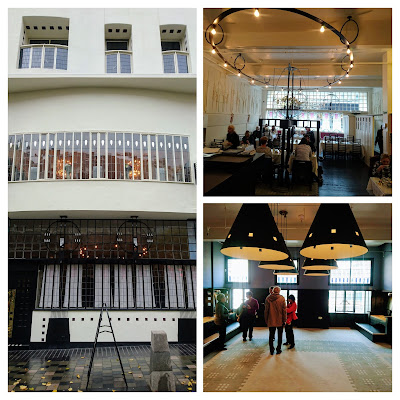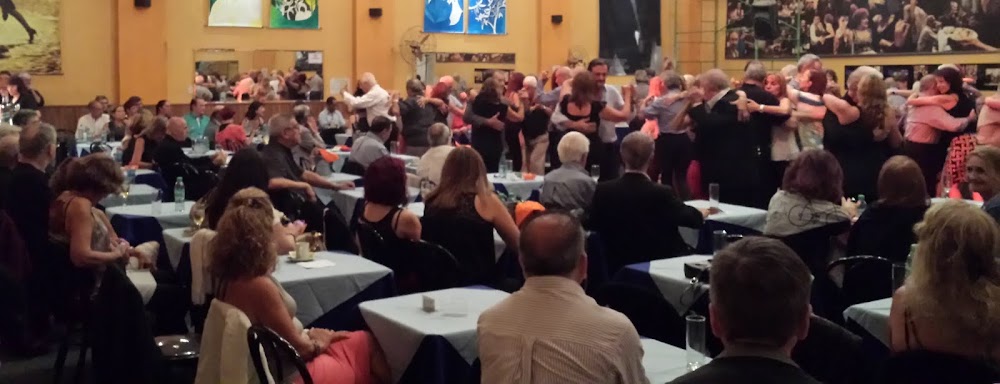Because most people who have learned to dance just want to dance, they don’t tend to think about showing new guys how to dance, by well, just dancing with them. It isn't, for many who think that learning is only something you do in class, one of the things you do to bring new people into the scene. So, sadly, beginners are often largely
ignored. It is the cultural legacy of that sink or swim attitude which infects scenes run by elitist and usually controlling individuals. You can recognise them because they are
notoriously unfriendly, or will even talk about the
downsides of being too generous.
There is however a community run practica in Glasgow. Glasgow does already have the redly named
Glasgow Tango Collective which was set up in the vacuum left after a teacher moved away and his milonga ended. It runs classes, a practica, a monthly milonga and special events. However, as with many of these ventures, it is really run by a teacher plus friends and I am not sure if the practica and milonga would survive independently of the individuals who set it up, as would a true community initiative.
This newer venture, called
Tango Mac has set up in a little known Charles Rennie Mackintosh building, the Ruchill Kelvinside Parish church hall.

It is off an unprepossessing section of Maryhill Road populated by tanning salons, tattoo and betting shops, nail bars and a Vape City. It was not, as far as I can gather, set up purely from altruistic motives. In a dramatic dagger-and-revenge move the rumour was it was initiated to supplant and shut down a teacher-led practica which runs at the same time, on the same day practically round the corner. This seems to have been largely successful since the numbers at the old practica when I last went in the autumn, had dropped from about forty attendees to a handful. I heard it continued thus until this old practica, which used to last for 2.5 or three hours, changed its format to be an hour and a half. It is now also split around two lots of lessons, making it attractive only to those who do the lessons or the private classes. That is actually useful because it keeps the social dancers away and usefully separates social dancers from class dancers and their very different styles of dance.
But from this dramatic start better good things may yet grow from that (metaphorical) spilt blood. Teachers were involved in setting up TangoMac from which one might suppose it was just another of the tactics to close down other teachers that happen in the tango world. Over the years I have seen these shark-like attacks are shocking in their flagrant callousness and viciousness and yet are remarkably common.
However, this practica is not preceded by classes as the other one is and ordinary dancers take it in turn to host and to DJ meaning they gain experience in these things. It is, potentially, just the kind of place where people might learn from one another. There are, though, not as many younger dancers in Glasgow as there might be. For a cosmopolitan city, Glasgow is in many ways quite traditional (though nothing like as conservative as Perth!) and a small-c conservative community, with a core of older members many of whom are already paired up in couples is not going to be as open to guys learning both roles, or even the concept of learning outside of class, as a generally younger set like the university tango society in say, St Andrews. Still, more people have a stake in this venture, have hosted it, have DJd for it and so its survival looks more assured than practicas or milongas that depend just on one or two people.
I went for the opening event on 15 September last year. I haven't been back yet. The floor is not the best and was slightly damaged in one part. I danced only one traditional track because the music was mostly cover versions of traditional tracks, modern orchestras or the more dramatic, 50s end of the traditional era. Over seven years I have noticed music in Glasgow has been consistently less traditional than in Edinburgh. I was delighted to be asked to DJ there but I like to DJ for people who prefer and appreciate traditional music, the well-loved popular classics that have been danced for decades and I do not feel this is yet the case in Glasgow. You can see how popular and busy this event was here with no chair not taken.

All was not lost though. I chatted with friends. Blane, as ever, cajoled me into a better mood and Kate was there with whom I love to chat. She mentioned this book and we talked about Spanish history. She told me about Oviedo, the Asturias and its role in the Reconquista.
 |
| Exterior, cafe interior and top floor, former gentlemen's room |
I feel now I should go back, even for the social bit and there is so much of Mackintosh's work I have yet to see in Glasgow. I have been to the Hill house which is now under renovation. In October last year I visited the gorgeous, newly restored
Mackintosh at the Willow tearooms on Sauchiehall Street, the only one still in its original location.
 |
| Design details |

'The Lighthouse' is another Mackintosh building. It was his first commission, to house what were the offices of Glasgow's newspaper, The Herald. It is down one of Glasgow's unsalubrious alleys not dissimilar, but not quite as bad as this one. There is a bright neon sign to show you the way. Mackintosh is known for the design of the exterior of this building. It may not seem like an obvious Mackintosh building but there are faint hints of what is to come in the future, around the top of the door for instance. You can read more about The Lighthouse building
here. Sometimes they run tours which are well worth doing. Inside there is a permanent exhibition dedicated to Mackintosh and his work.

The gates that form part of the side entrance to the building are interesting. When aligned together, they reveal the face of Margaret Morris, Mackintosh's wife.
There is still lots of Mackintosh I have yet to see, notably the
House for an Art Lover and the
Mackintosh House at the Hunterian. The new V&A museum in Dundee also houses the restored and reconstructed Mackintosh
Oak Room, the largest interior that he designed for Miss Cranston's Ingram Street Tearooms in Glasgow.
I loved the Tango Mac building where the practica was held. The exterior hints little at what there is inside though there are clues, especially around the lower windows.
It has some elegant features:

The building is used as a community hall and those features are in desperate need of conservation and restoration.
 |
| This elegant panel and archway houses the loos! |
There is a combination of the Mackintosh trademark geometric cubes and the flowing lines, curves and oval shapes (featured on the window above). Much is beautifully understated.

Some of the teachers involved in setting up this event run an occasional tea on the other side of Glasgow with more alternative music and superb cakes. One of the teachers is also an artist and made the attractive business cards in the Mackintosh style. Here is the special inauguration cake for the new practica which has now been running for six months.
In May 2015 I was delighted to post about Dundee tango society which, in its new incarnation outside the city had set up a
community practica though it soon turned class dominated. Their social dancing is only quarterly but the community-led milongas when I last went were in almost every respect very nice. I last went in
June 2016 and
October 2016 when I think I danced one track, but have not been back since. That is because of the music which is played by the teachers and the dancing that goes with that sort of music. It is not the popular classics, played and loved for decades, that I enjoy and need for dancing.
More recently, last month I went to TangoAires, a milonga in Liverpool that I had been trying to get to for several years. It has existed for 8 years, run in that time by different people. The entrada was cheap for most milongas in the UK: £5. I asked about the price and the milonga's history. It had been made into a social enterprise with a formalised structure meaning that the organiser could not as she said in her own words "just take any profit to spend on tango shoes". The whole idea was apparently to make it a community initiative, not something for one individual's benefit. I have to add that Helen is a quiet, and a wonderful dancer. Unsurprisingly, but unfortunately unlike most of the men there, she also dances
both roles. There was plenty of good music and I found there some of my favourite UK (women) dancers. The only problem was how busy the floor was in that relatively small space, which describes that milonga's popularity.










